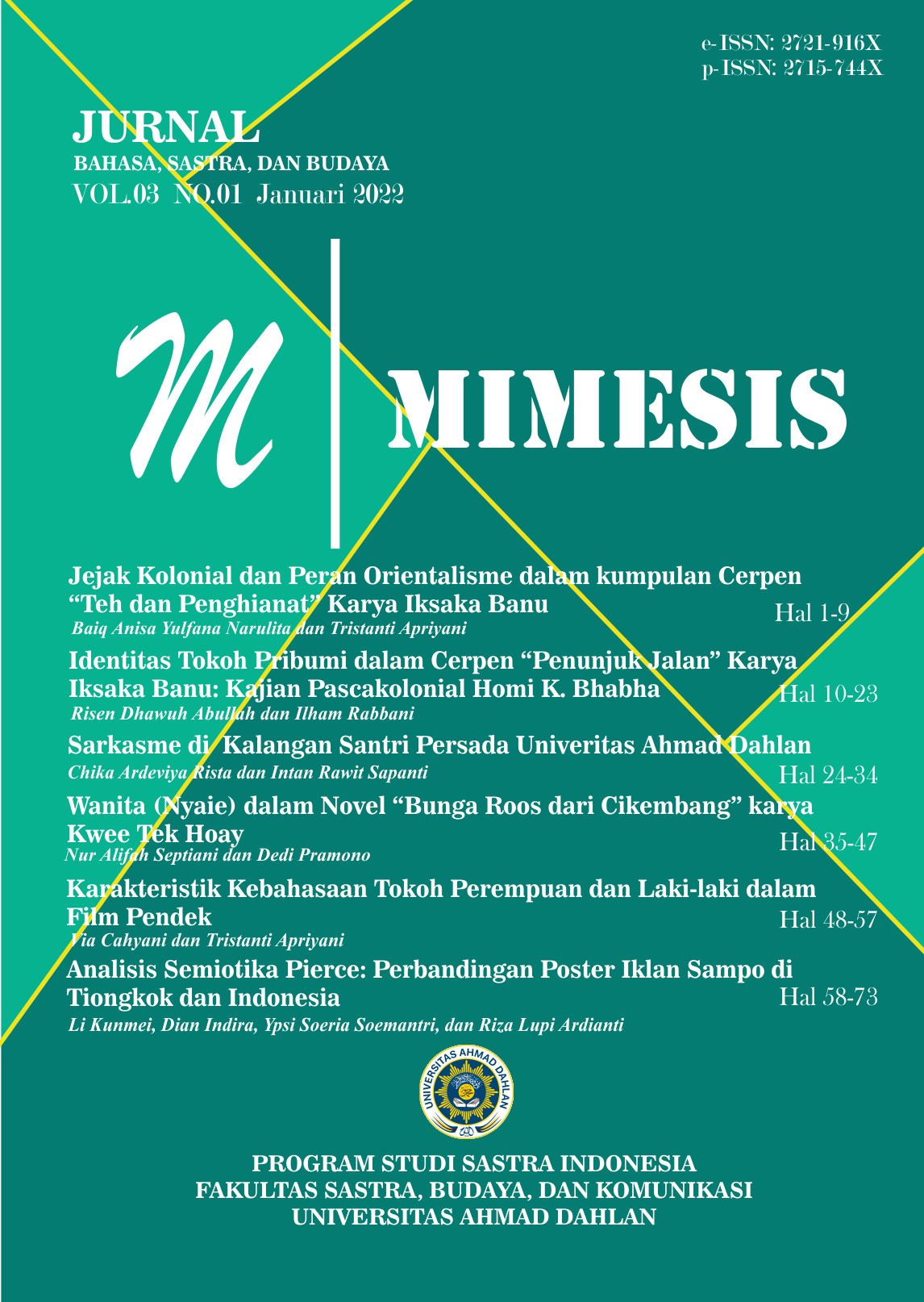WANITA (NYAIE) DALAM NOVEL BUNGA ROOS DARI CIKEMBANG KARYA KWEE TEK HOAY
DOI:
https://doi.org/10.12928/mms.v3i1.5545Keywords:
Conception of Woman, Concubine , Bunga Roos dari CikembangAbstract
Over 90 years (1870-1960), 800 authors published 3000 Chinese Malay erudite workshops. Bunga Roos from Cikembang is one of the most well-known workshops. The work was written by Kwee Tek Hoay, one of the most prolific authors of his day. Bunga Roos from Cikembang, similar to the previous Chinese Malay literary work, casts an indigenous womanish figure as a Chinese man's "nyaie." The distinction in this tale is that the "nyaie" is elevated to a higher status. She is no longer referred to as a "mistress" (a libido grater), but rather as a lady by her master, even though she has never been married. This distinction is noteworthy and warrants additional investigation. The goal of this research is to locate honorable examples for the female character who becomes the "nyaie" in a detail in this sense, the study theory employed a gender theory, specifically Richard A. Lippa's notions of nature and nurture. This research is the outcome of a library search. The data analysis was done in a descriptive-qualitative manner. Marsiti, like a lady"nyaie" (concubine) of a high-class Chinese, was lauded not only as a woman who satisfies her master's lust because of her beauty, sexiness, and service (nature) but also as a woman in a good social arrangement (nurture). Marsiti is seen as a "partner" who can be relied upon to help the master think through the various challenges that arise in his life as a result of his wimpiness, intelligence, and fidelity. In this case, the location of the woman "nyaie" in Kwee Tek Hoay's Cikembang Bunga Roos appears to be superior to the previous work.
References
Baay, R. (2017). Nyai dan Pergundikan di Hindia Belanda. Komunitas Bambu.
Fakih, M. (2012). Analisis Gender dan Transformasi Sosial. Pustaka Pelajar.
Faruk. (2012). Metode Penelitian Sastra: Sebuah Penjelajahan Awal. Pustaka Pelajar.
Hoay, K. T. (2001). Bunga Roos dari Cikembang (1927). In Kesastraan Melayu Tionghoa dan kebangsaan Indonesia Jilid 2. Kepustakaan Populer Gramedia.
Hudaa, S., Bahtiar, A., Haryanti, N. D., & Firdaus, W. (2021). Representasi Budaya dalam Novel Boenga Roos dari Tjikembang. Jentera, 10(1), 45–56.
Irenewaty, T., & Adhi, W. P. (2016). Eksistensi Perjuangan Wanita Masa Kolonial. Istoria, 11(2), 13–27.
Jaelani, G. A. (2020). Perempuan Sunda dan Pelacuran di Zaman Kolonial. Purbawidya, 9(2), 199–216.
Lippa, R. A. (2005). Gender, Nature, and Nurture. Lawrence Erlbaum Associates.
Meij, L. S. (2009). Ruang Sosial Baru Perempuan Tionghoa: Sebuah Kajian Pascakolonial. Yayasan Obor Indonesia.
Nugroho, A., & Purnomo, D. T. (2017). Citra Perempuan dalam Karya Sastra Peranakan Tionghoa. Buana Gender, 2(2), 165–176.
Pramono, D. (2010). Menelaah Pola Interaksi dalam Sastra Melayu Tionghoa. Forum Sastra Lamongan (FSL). https://forum-sastra-lamongan.blogspot.com/search?q=bunga+roos+
Pramono, D. (2019). Citra Wanita Pribumi dalam Sastra Melayu Tionghoa. Sesanti (Seminar Bahasa, Sastra, Dan Seni), 348–363.
Sungkowati, Y. (2009). Hubungan Etnis Jawa dan Tionghoa dalam Novel Tunggak-Tunggak Jati. Diksi, 16(1), 55–66.
Suryakusumma, J. (2012). Agama. Seks, dan Kekuasaan. Komunitas Bambu.
Suryani, & Azmy, A. S. (2016). Politik Identitas dan Nasionalisme Kebangsaan (Studi Atas Penguatan Politik Identitas Etnis Tionghoa di Indonesia Pasca Orde Baru).
Downloads
Published
Issue
Section
License
Copyright (c) 2022 Nur Alifah Septiani, Dedi Pramono

This work is licensed under a Creative Commons Attribution-ShareAlike 4.0 International License.
License and Copyright Agreement
In submitting the manuscript to the journal, the authors certify that:
- They are authorized by their co-authors to enter into these arrangements.
- The work described has not been formally published before, except in the form of an abstract or as part of a published lecture, review, thesis, or overlay journal.
- That it is not under consideration for publication elsewhere,
- That its publication has been approved by all the author(s) and by the responsible authorities tacitly or explicitly of the institutes where the work has been carried out.
- They secure the right to reproduce any material that has already been published or copyrighted elsewhere.
- They agree to the following license and copyright agreement.
Copyright
Authors who publish with Mimesis agree to the following terms:
- Authors retain copyright and grant the journal right of first publication with the work simultaneously licensed under a Creative Commons Attribution License (CC BY-SA 4.0) that allows others to share the work with an acknowledgment of the work's authorship and initial publication in this journal.
- Authors are able to enter into separate, additional contractual arrangements for the non-exclusive distribution of the journal's published version of the work (e.g., post it to an institutional repository or publish it in a book), with an acknowledgment of its initial publication in this journal.
- Authors are permitted and encouraged to post their work online (e.g., in institutional repositories or on their website) prior to and during the submission process, as it can lead to productive exchanges, as well as earlier and greater citation of published work.











